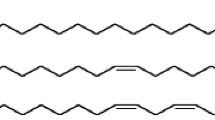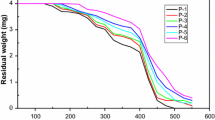Abstract
The article investigates the performance of polymers prepared from castor oil and dodecyl acrylate as biodegradable multifunctional additive in the formulation of eco-friendly lubricant. Homopolymer of castor oil and its copolymers with dodecyl acrylate (DA) at different percentage ratios (w/w) were synthesized using azobisisobutyronitrile (AIBN) as initiator without any solvent. The polymers were characterized by spectral techniques (FT-IR and NMR spectroscopy). The molecular weight of all the prepared polymers was determined by gel permeation chromatography (GPC). The thermal stability of the polymers was determined by thermogravimetric analysis (TGA). Performance evaluation of all the prepared polymers in SN150 mineral oil as viscosity index improver (VII), pour point depressant (PPD) and antiwear were carried out according to standard ASTM methods. The action mechanism of the additives as PPD was studied by photo micrographic image. Biodegradability of all the samples was tested through soil burial test (SBT).









Similar content being viewed by others
References
Adhvaryu A, Erhan SZ, Perez JM (2004) Tribological studies of thermally and chemically modified vegetable oils for use as environmentally friendly lubricants. Wear 257:359–367
Shanta SM, Molina GJ, Soloiu V (2011) Tribological effects of mineral-oil lubricant contamination with biofuels: a pin-on-disk tribometry and wear study. Adv Tribol. doi:10.1155/2011/820795
Kumar GS, Balamurugan A, Vinu S, Radhakrishnan M, Senthilprabhu G (2012) Tribological and emission studies on two stroke petrol engine lubricated with sunflower methyl ester. J Sci Ind Res 71:562–565
Liew WYH, Dayou S, Dayou J, Siambun NJ, Ismail MAB (2014) The effectiveness of palm oil methyl ester as lubricant additive in milling and four-ball tests. Int J Surf Sci Eng 8:153–172
Samarth NB, Mahanwar PA (2015) Modified vegetable oil based additives as a future polymeric material—Review. Open J Org Polym Mater 5:1–22
Sharma BK, Adhvaryu A, Erhan SZ (2009) Friction and wear behavior of thioether hydroxyl vegetable oil. Wear 42:353–358
Liu W, Hu L, Zhang Z (1995) Friction and wear of the film formed in the immersion test of oil containing antiwear and extreme pressure additives. Thin Solid Films 271:88–91
Li W, Jiang C, Chao M, Wang X (2014) Natural garlic oil as a high-performance, environmentally friendly, extreme pressure additive in lubricating oils. ACS Sustain Chem Eng 2:798–803
Mofijur M, Masjuki HH, Kalam MA, Shahabuddin M, Hazrat MA, Liaquat AM (2012) Palm oil methyl ester and its emulsions effect on lubricant performance and engine components wear. Energy Procedia 14:1748–1753
Liu Z, Sharma BK, Erhan SZ, Biswas A, Wang R, Schuman TP (2015) Oxidation and low temperature stability of polymerized soybean oil-based lubricants. Thermochim Acta 601:9–16
Adhvaryu A, Erhan SZ, Liu ZS, Perez JM (2000) Oxidation kinetic studies of unmodified and genetically modified vegetable oils using pressurized differential scanning calorimetry and nuclear magnetic resonance spectroscopy. Thermochim Acta 364(1–2):87–97
Fox NJ, Stachowiak GW (2007) Vegetable oil-based lubricants—a review of oxidation. Tribol Int 40(7):1035–1046
Sharma BK, Adhvaryua A, Liu Z, Erhan SZ (2006) Chemical modification of vegetable oils for lubricant applications. J Am Oil Chem Soc 83:129–136
Sharma BK, Doll KM, Erhan SZ (2007) Oxidation, friction reducing, and low temperature properties of epoxy fatty acid methyl esters. Green Chem 9(5):469–474
Sharma BK, Liu Z, Adhvaryu A, Erhan SZ (2008) One-pot synthesis of chemically modified vegetable oils. J Agric Food Chem 56(9):3049–3056
Biswas A, Sharma BK, Willett JL, Erhan SZ, Cheng HN (2008) Soybean oil as a renewable feedstock for nitrogen-containing derivatives. Energ Environ Sci 1:639–644
Shashidhara YM, Jayaram SR (2010) Vegetable oils as a potential cutting fluid—an evolution. Tribol Int 43(5–6):1073–1081
Erhan SZ, Sharma BK, Liu Z, Adhvaryu A (2008) Lubricant base stock potential of chemically modified vegetable oils. J Agric Food Chem 56(19):8919–8925
Campanella A, Rusto E, Baldessari A, Baltanás MA (2010) Lubricants from chemically modified vegetable oils. Bioresour Technol 101(1):245–254
Sharma BK, Doll KM, Erhan SZ (2008) Ester hydroxy derivatives of methyl oleate: tribological, oxidation and low temperature properties. Bioresour Technol 99:7333–7340
Erhan SZ, Asadauskas S (2000) Lubricant base stocks from vegetable oils. Ind Crops Prod 11(2–3):277–282
Lathi PS, Mattiasson B (2007) Green approach for the preparation of biodegradable lubricant base stock from epoxidized vegetable oil. Appl Catal B Environ 69:207–212
Ogunniyi DS (2006) Castor oil: a vital industrial raw material. Bioresour Technol 97:1086–1091
Mutlu H, Meier MAR (2010) Castor oil as a renewable resource for the chemical industry. Eur J Lipid Sci Technol 112(1):10–30
Kunduru KR, Basu A, Zada MH, Domb AJ (2015) Castor oil-based biodegradable polyesters. Biomacromol 16(9):2572–2587
Azambujaa MA, Diasb AA (2006) Use of castor oil-based polyurethane adhesive in the production of glued laminated timber beams. Mater Res 9(3):287–291
Ibrahim S, Ahmad A, Mohamed NS (2015) Characterization of novel castor oil-based polyurethane polymer electrolytes. Polymer 7:747–759
Singh AK (2011) Castor oil-based lubricants reduces smoke emission in two stroke engines. Ind Crop Prod 33:287–295
Sánchez R, Fiedler M, Kuhn E, Franco JM (2011) Tribological characterization of green lubricating greases formulated with castor oil and different biogenic thickener agents: a comparative experimental study. Ind Lubr Tribol 63:446–452
Borugadda V, Goud V (2016) Improved low-temperature properties of chemically modified high free fatty acid castor oil-methyl esters: blending and optimization study. J Energ Eng. doi:10.1061/(ASCE)EY.1943-7897.0000283
Quinchia LA, Delgado LA, Reddyhoff T, Gallegos C, Spikes HA (2014) Tribological studies of potential vegetable oil-based lubricants containing environmentally friendly viscosity modifiers. Tribol Int 69:110–117
Chincholkar DS, Salpute ST, Kumbhar NR (2012) Castor oil as green lubricant—a review. Int J Eng Res Technol 1(5):1–3
Madankar CS, Pradhan S, Naik SN (2013) Parametric study of reactive extraction of castor seed (Ricinus communis L.) for methyl ester production and its potential use as bio lubricant. Ind Crop Prod 43:283–290
Majumdar S, Kumar D, Nirvan YPS (1998) Acrylate grafted dehydrated castor oil alkyd—a binder for exterior paints. J Coatings Technol 70:27–33
Karmakar G, Ghosh P (2015) Soybean oil as a biocompatible multifunctional additive for lubricating oil. ACS Sustain Chem Eng 3:19–25
Chandure AS, Umare SS (2007) Synthesis, characterization and biodegradation study of low molecular weight polyesters. Int J Polym Mater 56:339–353
Tanveer S, Sharma UC, Prasad R (2006) Rheology of multigrade engine oils. Indian J Chem Technol 13:180–184
Karmakar G, Ghosh P (2013) Green additives for lubricating oil. ACS Sustainable Chem Eng 1:1364–1370
Morgan S, Ye Z, Subramanian R, Zhu S (2010) Higher-molecular-weight hyperbranched polyethylenes containing crosslinking structures as lubricant viscosity-index improvers. Polym Eng Sci 50:911–918
Soni HP, Kiranbala Bharambe DP (2008) Performance-based designing of wax crystal growth inhibitors. Energy Fuels 22:3930–3938
El-Gamal IM, Atta AM, Al-Sabbagh AM (1997) Polymeric structures as cold flow improvers for waxy residual fuel oil. Fuel 76:1471–1478
Behbahani TJ (2014) Experimental investigation of the polymeric flow improver on waxy oils. Pet Coal 56:139–142
Eckermann DIB, Vogelpohi IA (1990) Deasphaltization and demetalling of heavy crude oil and distillation residues with CO2. Chem Eng Technol 13:258–264
Tan Y, Huang W, Wang X (2002) Molecular orbital indexes criteria for friction modifiers in boundary lubrication. Tribol Int 35:381–384
Masjuki HH, Maleque MA (1997) Investigation of the anti-wear characteristics of palm oil methyl ester using a four-ball tribometer test. Wear 206:179–186
Matthew TS, Nader S, Bigyan A, Lambert AD (2007) Influence of fatty acid composition on the tribological performance of two vegetable-based lubricants. J Synth Lubr 24:101–110
Acknowledgement
Thanks to UGC, New Delhi for financial support. Special thanks to IOCL, India for providing the base oil.
Author information
Authors and Affiliations
Corresponding author
Electronic supplementary material
Below is the link to the electronic supplementary material.
Rights and permissions
About this article
Cite this article
Ghosh, P., Hoque, M. & Karmakar, G. Castor oil as potential multifunctional additive in the formulation of eco-friendly lubricant. Polym. Bull. 75, 501–514 (2018). https://doi.org/10.1007/s00289-017-2047-6
Received:
Revised:
Accepted:
Published:
Issue Date:
DOI: https://doi.org/10.1007/s00289-017-2047-6




